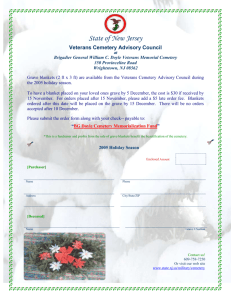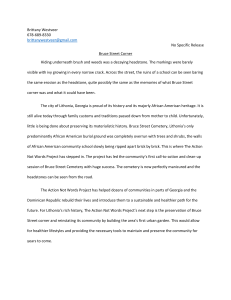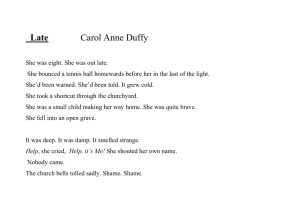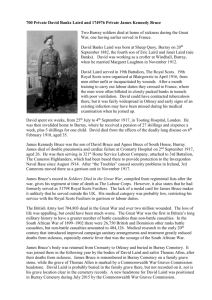JL12_Twice
advertisement
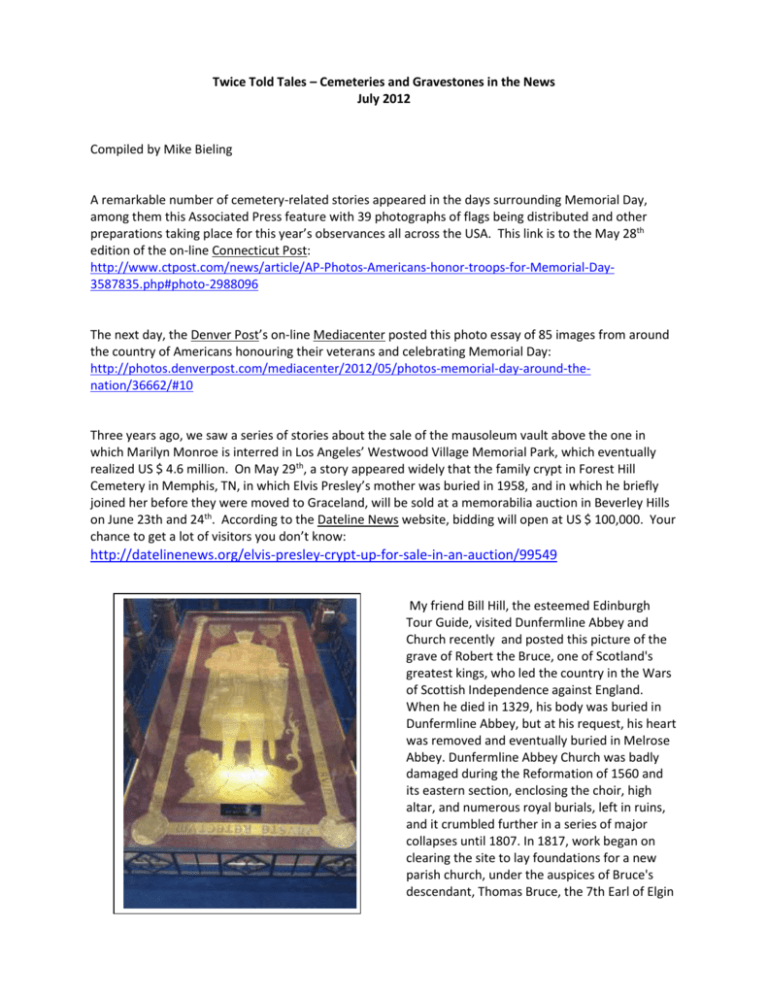
Twice Told Tales – Cemeteries and Gravestones in the News July 2012 Compiled by Mike Bieling A remarkable number of cemetery-related stories appeared in the days surrounding Memorial Day, among them this Associated Press feature with 39 photographs of flags being distributed and other preparations taking place for this year’s observances all across the USA. This link is to the May 28th edition of the on-line Connecticut Post: http://www.ctpost.com/news/article/AP-Photos-Americans-honor-troops-for-Memorial-Day3587835.php#photo-2988096 The next day, the Denver Post’s on-line Mediacenter posted this photo essay of 85 images from around the country of Americans honouring their veterans and celebrating Memorial Day: http://photos.denverpost.com/mediacenter/2012/05/photos-memorial-day-around-thenation/36662/#10 Three years ago, we saw a series of stories about the sale of the mausoleum vault above the one in which Marilyn Monroe is interred in Los Angeles’ Westwood Village Memorial Park, which eventually realized US $ 4.6 million. On May 29th, a story appeared widely that the family crypt in Forest Hill Cemetery in Memphis, TN, in which Elvis Presley’s mother was buried in 1958, and in which he briefly joined her before they were moved to Graceland, will be sold at a memorabilia auction in Beverley Hills on June 23th and 24th. According to the Dateline News website, bidding will open at US $ 100,000. Your chance to get a lot of visitors you don’t know: http://datelinenews.org/elvis-presley-crypt-up-for-sale-in-an-auction/99549 My friend Bill Hill, the esteemed Edinburgh Tour Guide, visited Dunfermline Abbey and Church recently and posted this picture of the grave of Robert the Bruce, one of Scotland's greatest kings, who led the country in the Wars of Scottish Independence against England. When he died in 1329, his body was buried in Dunfermline Abbey, but at his request, his heart was removed and eventually buried in Melrose Abbey. Dunfermline Abbey Church was badly damaged during the Reformation of 1560 and its eastern section, enclosing the choir, high altar, and numerous royal burials, left in ruins, and it crumbled further in a series of major collapses until 1807. In 1817, work began on clearing the site to lay foundations for a new parish church, under the auspices of Bruce's descendant, Thomas Bruce, the 7th Earl of Elgin (of "Elgin Marbles" fame - or "Parthenon Marbles" infamy, depending on your point of view). In February 1818, workers digging around the old high altar uncovered a grave beneath two large stones, in which they found the remains of an oak coffin containing a complete skeleton sealed inside two layers of thin lead, with the remnants of a shroud of cloth of gold over it. The man's breastbone had been split open and the skull wore a simple lead crown. Around the grave were broken pieces of black and white marble, which scholars linked to a marble sarcophagus known to have been purchased by Robert the Bruce. It was therefore immediately identified as his grave, though more definitive evidence was never found. After careful inspection and description, the remains were placed in a new lead coffin, which was then filled with 1,500 pounds of hot poured pitch and re-interred in a new brick vault within the stillrising walls of the new church on November 5, 1819. The grave remained unmarked, as arguments over an appropriate monument arose and continued until 1889, when Victor Bruce, the 9th Earl of Elgin, donated this relief effigy brass in honour of Queen Victoria's Jubilee. So, although faithful in design and execution to a 14th century memorial, this brass is a Victorian re-creation. This is quite a bit of introduction to the best source of information I was able to uncover for this story: Michael A. Penman’s 2009 doctoral thesis, “Robert Bruce’s Bones: Reputations, Politics and Identities in Nineteenth-Century Scotland”. In this 68-page PDF document, Penman, a Senior Lecturer in History at the University of Stirling in Scotland, examines the discovery of Robert the Bruce’s original burial and the politics involved in the king’s reburial and the eventual erection of this monumental brass: http://www.irss.uoguelph.ca/article/viewFile/1075/1537 The next day, Bill posted this photo, taken by his friend Cameron Goodall in Dunfermline Abbey Church near Robert the Bruce’s grave, of a copy of a plaster cast taken of the skull believed to be that of the king after the discovery of his original grave in 1818. During construction of the new church, the remains from the grave were studied and described by medical experts, and an accurate Plaster of Paris cast of the skull and mandible taken by W. Scoular. The original cast is in the Anatomy Museum of the University of Edinburgh, and has been the basis of several historical portraits and, more recently, reconstructions of the king’s features by forensic specialists. Damage to the upper jaw and facial bones tends to support the theory that the king suffered from leprosy, but because the cast doesn’t show the skull’s hard palate, we cannot be certain. Page 68 of this PDF copy of Maria Venezi’s 2007 doctoral dissertation, “Forensic Facial Reconstruction Using 3-D Computer Graphics: Evaluation and Improvement of Its Reliability in Identification", illustrates a series of these reconstructions of Robert the Bruce's face, using several different techniques: http://theses.gla.ac.uk/375/01/2008vanezisphd.pdf May 31st brought a flurry of stories about the identification and relocation of a 136 year old tombstone, found tossed on the side of the road and stored in a police evidence locker in Milford, CT, for the past 35 years. The most detailed of these was in the Connecticut Post’s website: http://www.ctpost.com/news/article/Milford-solves-mystery-of-missing-tombstone-3598899.php In Canada, the end of May and early June marks the time during which branches of the Royal Canadian Legion veterans’ organization hold candlelight vigils in veterans’ cemeteries across the country. Under the direction of Legion officers, members of local Army, Navy, and Air Cadet Corps, and of the Boy Scouts and Girls Guides, set out a lighted candle in a glass lantern overnight on the grave of each veteran. The following article from the website of the Saanich News of Victoria, B.C., of May 28th, describes the service held at “God’s Acre” Veterans’ Cemetery in Esquimalt, which has its origins in the Victorian-era cemetery of the Royal Navy’s Pacific Station there: http://www.saanichnews.com/community/154893075.html On June 4th, the Roanoke Times of Roanoke, VA, featured an interesting article about the meaning and significance of the three words – “Mammy, At Rest” – inscribed on the gravestone of a woman buried in the cemetery at St. Thomas Episcopal Church in Sedalia, VA. These words were analyzed by three academics familiar with social relations between employers and former slaves in the post-Civil War South: http://www.roanoke.com/news/roanoke/wb/309713 An innovation in 4G smartphone technology was announced in an article on June 8th on the Sci-Tech Today.com website, describing a GPS app that has been developed that allows one to locate any of the more than 250,000 graves in Arlington National Cemetery with military accuracy. A by-product of the intensive, high-tech check of the entire inventory of burials there that followed the mismanagement scandal of several years ago, this system will also allow “virtual visits” to Arlington gravesites on-line: http://www.sci-tech-today.com/news/App-Pinpoints-ArlingtonGraves/story.xhtml?story_id=020002G0DX7O Another item about technology in the graveyard appeared the same day in the Detroit Free Press, which explained how the Monumark Tag uses a highly adhesive aluminum tag, imprinted with data in “QR” code, which can be scanned by a smartphone to direct it to a website about the deceased: http://www.freep.com/article/20120608/FEATURES01/206080436/QR-Code-tombstone-offers-newway-to-remember-loved-ones This story and video clip, from The Huffington Post’s website of June28th, tells how visitors to San Francisco’s Ocean Beach have recently been finding old gravestones eroding out of the beachfront and how these came to be there following the clearance of the city’s old cemeteries and the movement of the dead to Colma, “The City of the Dead”: http://www.huffingtonpost.com/2012/06/07/san-francisco-gravestones_n_1579388.html Mike Bieling lives in Duncan, B.C., and can be reached at oldcemeterian@shaw.ca



